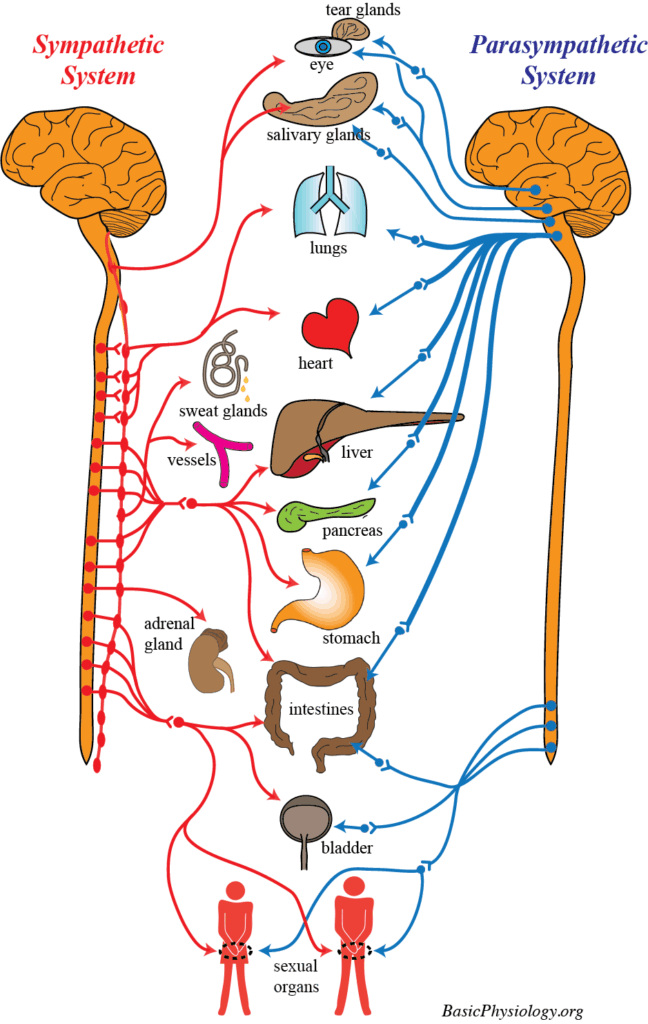H.6. Autonomic Nervous System
A. Introduction:
1.
Autonomic Nervous System!! This is a nervous system that is autonomic; that is; independent (to a certain degree) of the CNS.
2.
It is like having a robot inside your body that controls things that you have no idea about!
3.
I am not exaggerating. This part of the nervous system is very busy controlling many things in our body.
4.
As you can see in the diagram, the autonomic nerves are projecting into an immense number of internal organs, from the heart and the lungs, to the intestines, all kind of glands, etc.
5.
The autonomic nervous system, is also called the vegetative system or the involuntary system.
6.
It involves ‘controlling’ five different intestinal systems:
- the Circulatory system
- the Respiratory system
- the Digestive system
- the Urinary and Genital system
- the Skin
7.
Not only must all these systems be ‘regulated’, but they must also be coordinated and work together.
8.
For example, it is pointless to force the heart to pump harder and the lungs to decrease breathing at the same time; that would contradict each other. Of course, that shouldn’t happen!
9.
The autonomic nervous system consists of two systems that are each other’s opposite:
a) The Sympathetic System
b) The Parasympathetic System
10.
All the internal organs are controlled by both systems whereby the sympathetic usually ‘excites’ the organ while the parasympathetic system ‘inhibits’ these organs.
1.
The sympathetic system starts with several nuclei, located in the hypothalamus, the medulla oblongata, and the spinal cord.
2.
As you can see in the diagram, the nerves from these centers leave the Central Nervous system into a string of nuclei, many of them located as a ‘string’ running parallel to the spinal cord.
3.
In these nuclei, the nerves connect through a synapse to a second nerve that connects to the intestinal organs.
4.
It is actually quite a complicated network of nuclei and synapses, that must be very interesting for neurophysiologist. But for us, basic students, the important thing to remember is that the sympathetic nerves runs from the central nervous system, to all the internal organs in the body; that’s enough!
5.
What is much more interesting and relevant is what does the sympathetic system do? In one word: WORK!
6.
The sympathetic system excites (= stimulates) the internal organs. This is necessary when the body is going to exercise, strong emotions, harder working, fear, or anger!
7.
In those situations, more energy is required for muscles to work harder, so the lungs and the heart must work harder and/or stronger to pump more oxygen to these muscles, and more sugar and adrenaline is also required for this to happen.
8.
But, at the same time, the work of some other internal organs simultaneously be decreased. For example, the stomach and the intestine must work less or else they would interfere with the harder work that the heart and the lungs have to perform.
9.
So, there is a delicate balance between those internal organs that are working harder while other organs work less.
10.
You can also see that in the behavior of the blood vessels. During the sympathetic drive, the blood vessels to the skeletal muscles will dilate (to transport more oxygen and nutrients to the muscles), while the blood vessels to the intestines will constrict. Perfect balance!
1.
As you can now understand, the parasympathetic system is the opposite of the sympathetic system!
2.
Instead of activating or simulating our body, the parasympathetic system calms it down!
3.
The parasympathetic system decreases the heart rate and contraction, lowers the breathing of our lungs, narrows the blood circulation to the skeletal muscles, etc.
4.
And, again, as the opposite of the sympathetic system, it also activates some internal organs that are useful in restoring and keeping our body healthy, by stimulating the intestines, dilating the relevant blood vessels, storing energy in our cells, so that we are again prepared for another sympathetic ‘attack’!
5.
There is one more important thing to remember in the parasympathetic system, and that is the presence of the most important nerve in our body; the vagus nerve.
6.
As you can see in the diagram, in contrast to the innervation of the sympathetic system, most of the parasympathetic nerves run though one ‘huge’ nerve, the vagus nerve.
7.
Only high in the brain and the upper part of the spinal cord, and in the most distal part of the spinal cord, do other parasympathetic nerves connect to their respective organs.
8.
But the vast majority of the internal organs are parasympathetically connected through the vagus nerve. Remember!



